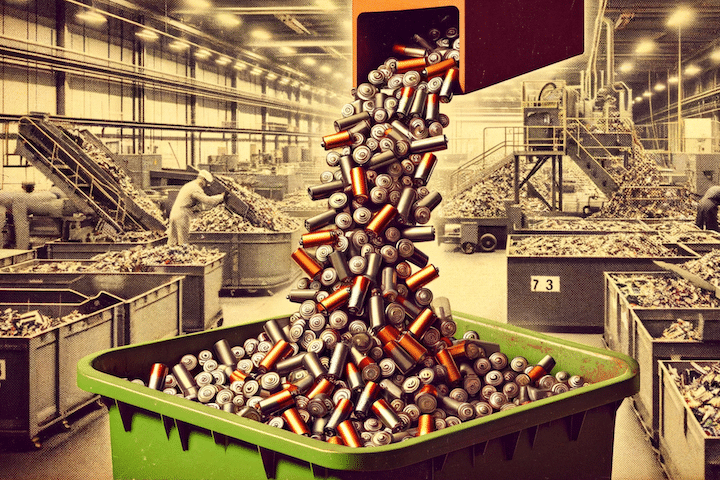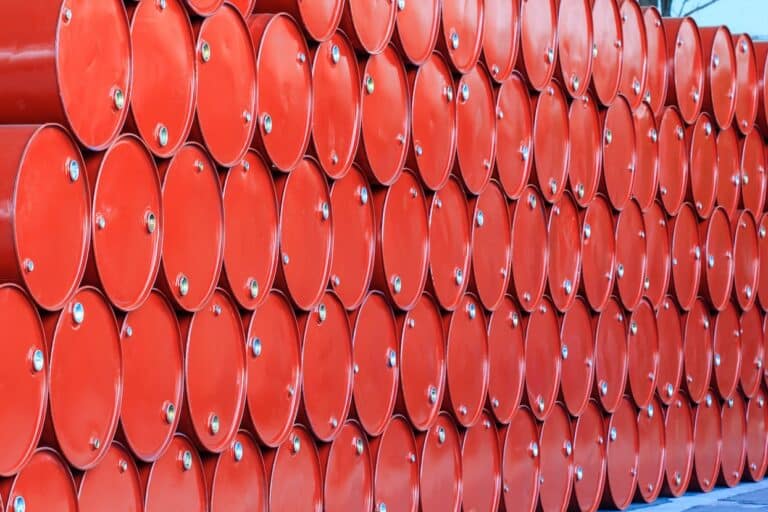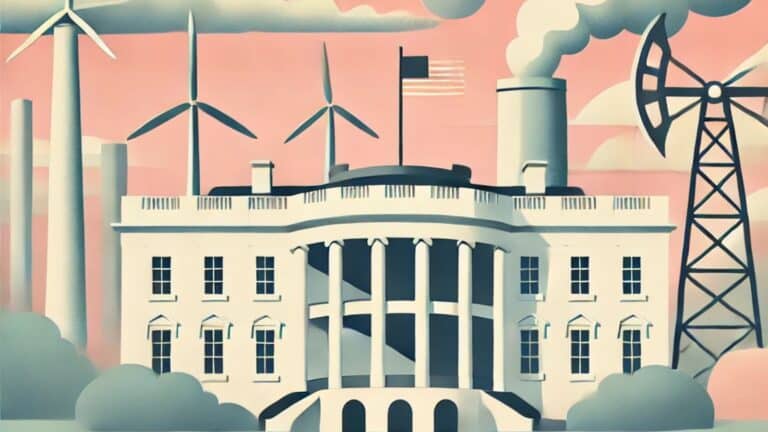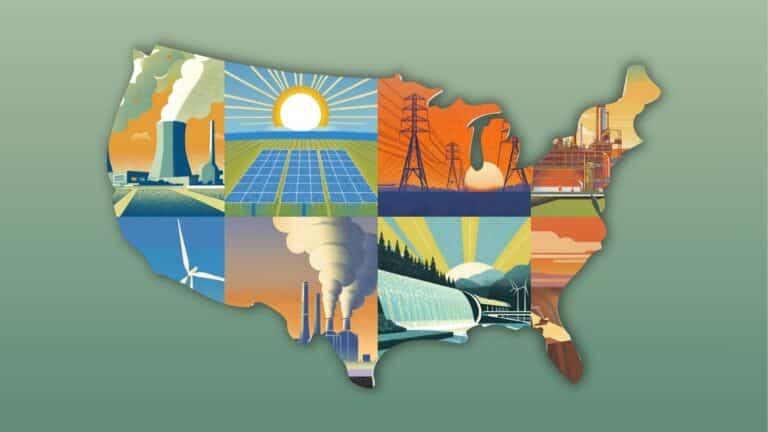Melissa Lott: [00:00:00] Hey, all this is Melissa. It’s been a while, and I just say, I hope you had a really great month while you’re away. I wanted to take a moment before we get into the show today to say that the big switch is back. Well, we’re going to switch things up a little bit, pun intended. So until now, we’ve been taking you on this decarbonization tour, looking at each sector of our economy, from industry to transportation to housing, and asking how we’re going to get each of those sectors to net zero. But over the summer, I stepped into a new role as an advisor to the United Nations secretary general. And it’s got me thinking a little bit differently. I’m a part of this group called the Council of Engineers for the Energy Transition, and I know it’s definitely a mouthful, but stick with me. This council has a goal of showing that getting to net zero by 2050 is really possible. Like, we already have a lot of the technologies that we need and the knowledge to get there. So this group will be getting together in person for the first time at something called the Conference of the Parties or COP 27. We’ll be meeting in Sharm el-Sheikh, which is in Egypt. And in the meantime, we’re meeting every week on Zoom, and I am learning a ton about how the energy transition is already taking place in different countries around the world. So over the next few weeks, I wanted to bring some of that philosophy to the show because we want to show you that this thing, this thing we’ve been talking about, the big switch. It’s already here in communities around the country and around the world. People aren’t just trying to make the net zero feature a reality. They’re succeeding. And we’re going to take you to those places, to communities just like yours. Anyway, that’s it, the new big switch. And this week, we’re going to take you to a place that I know pretty well, New York City. So let’s get into it. We just wrapped up our series about decarbonizing buildings. And if you haven’t had a chance to listen to that, definitely go back and check it out. But today, we’re going to dive into a city in America that’s pretty tricky to decarbonize. I’m talking about New York City. More than 70% of the city’s carbon emissions come from its buildings, and reducing emissions and buildings became a big priority in 2019 when the New York City Council passed a set of laws called the Climate Mobilization Act. [00:02:12][132.0]
Newsreels: [00:02:12] Adopted by a vote of 45 in the affirmative to negative and zero abstentions by nearly unanimous votes, the city Council passed a series of measures called the Climate Mobilization Act. It’s designed to reduce the city’s emissions by 40% by the year 2030. [00:02:31][18.8]
Melissa Lott: [00:02:32] At the time, the Climate Mobilization Act was the biggest climate plan of any city in the world, and the city council recognized that a huge chunk of New York City’s emissions came from buildings. So in their plan, they included this law called Local Law 97. This law said that buildings across the city have to cut their emissions by 80% by 2050, 80%. This is a huge deal. We’ve talked a lot in this last series about how building decarbonization is tied to equity and how in New York and in cities across the country, the communities hit hardest by the impacts of extreme heat are low income and communities of color. And these communities are often those that don’t have access to the heating and cooling that would keep them safe. So today we want to tell you about a project that’s tackling both of these things, decarbonization and equity at the same time. [00:03:24][51.7]
Governor Kathy Hochul: [00:03:30] We decided to launch a competition. As I mentioned, I’m a little bit competitive, right? I love competitions. [00:03:34][3.9]
Melissa Lott: [00:03:35] This is New York State Governor Kathy Hochul. It’s this hot day in early August. And while she’s speaking, she’s looking out at the small group of people who’ve gathered outside the Woodside houses in Queens. And she’s talking about this competition that was launched by a group of New York City and state agencies. The competition is called the Clean Heat for All Challenge. [00:03:55][19.7]
Governor Kathy Hochul: [00:03:56] We’re here today to talk about prioritizing green investments in public housing. No one has focused on this before. No one has done this before. And in the process, we’re going to spur innovation for brand new technologies here in New York that the rest of the nation will be looking at. [00:04:11][15.6]
Melissa Lott: [00:04:12] The New York City Housing Authority is what folks also call nature. It’s the largest public housing authority in the country, and it serves over 300,000 residents. And a lot of these residents who live in apartments. Well, I mean, over the years, they’ve faced some pretty horrible conditions, especially when it comes to heating and cooling. I’m talking about boiling hot apartments in the summers or freezing cold ones in the winters. And now nature is faced with a new challenge. How can they provide electric heating and cooling to their residents in buildings that are aging? And so nature has turned to the heating and cooling industry. And they said, Y’all, we need you to design something for us that will address both of these issues. And we know it’s going to be something that just doesn’t exist yet. [00:04:57][45.2]
Governor Kathy Hochul: [00:04:58] And as a result, industry and manufacturers have a competition to have a new design for a heat pump that can be deployed for the first time right here in nature housing. [00:05:07][9.7]
Melissa Lott: [00:05:09] And this technology, it can not only make nature housing safer, more comfortable, it could also revolutionize the building decarbonization in apartments across the country and around the world. This is the big switch. A show about how to rebuild the energy systems that are all around us. I’m Dr. Melissa Lott and I’m the director of research at Columbia University’s Center on Global Energy Policy. I want to back up for a second and talk about the heat pump. It’s the technology that this entire competition revolves around. And we’ve talked about heat pumps on the show before. They’re really important when it comes to building electrification, and therefore, they’re important when it comes to building decarbonization. Heat pumps can both heat and cool buildings using only electricity. So you don’t need a gas boiler. But right now, most heat pumps aren’t designed for apartments, especially older apartments, which means that they’re pretty inaccessible for most people living in New York City. But the clean heat for all challenge, it could change everything. The clean heat for All challenge was put by the state of New York to the heat pump and it track industry more broadly, which is that the New York City Housing Authority will buy a certain number of heat pumps if the industry is able to produce something that will work in a window similar to a window AC unit. This is Lisa Martine Jenkins. She’s a clean tech reporter for protocol, and she was there at Woodside when Governor Hochul announced the winners of this competition. It’s a really big deal because this is basically providing a market for this product that does not already exist. So to be really clear on this nature kind of took a gamble here. They said, look, heat pump industry, we know this technology doesn’t exist. But if you make it, will buy it. And we’re not just going to buy one or two or even a thousand, we’re going to buy 30,000 of these units. So fast forward till after this competition was completed. Back in Queens, Governor Hochul is standing in this crowd on this really hot day. And on either side of her are the results of the competition. Two model windows and each one of them has this small white box hanging off of it. These are the heat pumps. And soon they’re going to be in thousands of nature apartments. And it’s not just nature residents that can benefit. This is something that could really revolutionize the way that that renters and apartment dwellers heat and cool their homes. And now this technology that didn’t exist before, suddenly it does. [00:07:56][167.2]
Vents Ramanan: [00:08:02] New York City. A clean sheet for our challenge is really exciting to us was when it first came out as well, because we had been talking about some of the challenges in buildings and hadn’t heard a lot of other people kind of bring it up in the way they did. And so this program is is really, I think, focusing on the right challenges. When you talk about some of the challenges of climate change and doing it in a way that’s pushing the market forward. [00:08:27][24.6]
Melissa Lott: [00:08:28] This is Vents Ramanan. He’s the CEO of Gradient, which is one of the companies that ended up winning the Clean Heat for All Challenge. Can you tell us a little bit about the New York City clean heat for all challenge? So what is it? What’s the goal? And how did y’all at Gradient get involved in this? [00:08:42][14.4]
Vents Ramanan: [00:08:43] They want what we want. They they said in this program, not only do we need to decarbonize buildings partially to hit targets for local law, 97 buildings in New York now need to reduce their carbon footprint because of this law, but also that we need to do it in a way that focuses on resident comfort, that focuses on infrastructure resilience, and that focuses on equity in the sense that we need to be decarbonizing, but also making sure that the effects of climate change don’t hit our most vulnerable populations. The worst. [00:09:14][31.6]
Melissa Lott: [00:09:15] Aging heating infrastructure was already causing with some problems. And then Hurricane Ida hit New York last August and Woodside was particularly impacted. [00:09:23][7.5]
Diana Ross: [00:09:26] Well, Hurricane Ida here, I would say the houses, it took down, all of our basements. Everything that was below ground was severely damaged. [00:09:37][11.1]
Melissa Lott: [00:09:38] You’re hearing Diana Ross. She’s assistant superintendent at Woodside Houses, and she was there on the day that Ida hit. [00:09:45][6.5]
Diana Ross: [00:09:45] It was a natural disaster. I mean, it shook me that morning. It almost took me about an hour and a half to 2 hours just to get to work from all the detours. When I finally arrived at work, I could not into my office because it was three feet under water. [00:10:02][16.5]
Melissa Lott: [00:10:03] The boiler room at Woodside was underground and so the boilers were also damaged and it knocked out heat and hot water for about 2000 residents. [00:10:10][7.3]
Diana Ross: [00:10:11] Every last resident in the development was affected. [00:10:14][2.9]
Melissa Lott: [00:10:15] Nature was able to get these mobile boilers running in the apartment complex within a few days. But the Queens Chronicle reported that some residents were affected by heat and water outages into February of this year. But replacing the building’s aging boilers with heat pumps and individual units could change everything. [00:10:32][16.9]
Diana Ross: [00:10:33] If we have a natural disaster like this again and where we have the heat units, I mean, the only thing I could foresee is we lose power. Then we won’t have the heat units. But as far as the water and the boiler systems, it won’t be impacted in that type of way anymore because the systems are not ran underground in the boilers. So as long as you plug up your heat unit and you turn it on, no matter what’s going on outside, you’ll still have the heat are a air conditioning unit. [00:11:05][32.0]
Melissa Lott: [00:11:10] In other words, in the aftermath of an event like ETA, heat can be restored quickly and in the hot summer months, the heat pumps can help to nature doesn’t currently provide cooling to their residents, so residents have to purchase and install their own AC. [00:11:23][13.9]
Diana Ross: [00:11:24] So that’s why it’s thought that this program will really be good for residents that can’t afford the cooling part of it, especially seniors and stuff. They can’t get out to purchase this or have someone install it for them. So now they have their own type of cooling system in every room. So it sounds like it will be a very benefit from residents here with their houses. [00:11:48][23.9]
Melissa Lott: [00:11:49] So these heat pumps will tackle a lot of problems. The help electrify heating and cooling to meet the goals of local I-90 seven, which is the centerpiece of the Climate Mobilization Act, to also help residents stay cool during summer heat waves. And they’ll make the complex more resilient to extreme weather events like hurricanes. And to top it all off, this technology might make retrofitting an apartment building with heat pumps a whole lot cheaper for everyone. Here’s Venice again. [00:12:16][26.4]
Vents Ramanan: [00:12:17] From an economic standpoint. They said when they announced this challenge that these older buildings are really expensive to retrofit with heat pumps today, because most heat pumps on the market or all heat pumps on the market require a lot of construction on the building. It means a refrigerant technician who needs to connect the refrigerant lines of these systems and make sure that they are properly charged and sealed. And it also means an electrician who has to wire them to electrical mains. And they said if there was something that required zero building modification, did it require any skilled modification of the building or of the refrigeration cycle and plug in to 120 watt AC We could electrify way faster. And all of these things are the things that we want it. It was the thing that we were building. [00:12:59][42.1]
Melissa Lott: [00:12:59] And I know in a past interview you’re quoted saying, and as the largest public housing authority in North America, nature faced an interesting challenge with Local 97 putting heat pumps in buildings that just weren’t designed for them. And I think that’s what you’re getting at here, which is the idea you’ve got this building and you can have to make some pretty significant changes to put a heat pump in them. Yeah, it’s not just surface level, you know, switch out existing equipment is put something else in its footprint. It’s a lot more intense. Is that is that right? [00:13:27][27.6]
Vents Ramanan: [00:13:27] Yeah, exactly. And if you go back to why heat pumps are important, they’re important because they just use way less energy to heat a room than you do to burn a fuel to do it. It’s a little bit crazy that we have been heating our homes effectively the same way for about a million years, which is find something that burns and set it on fire. That’s still how we heat our homes. We find natural gas instead of whatever else it is, and we set it on fire. Cooling is is really new. Cooling we’ve had for the core tech are the fundamental innovation 200 years. But really in deploying it in our buildings, we have had cooling for less than 100 years. And what cooling does is instead of, you know, cause a chemical reaction that generates heat, it just moves heat from one place to another. And so an air conditioner does this process the same way a heat pump does. You just have to be able to reverse it. You have to be able to point the cycle the other direction so that you’re instead of moving heat from the inside of your hot room into the outside of the house in summer, in winter, you’re taking heat from outside and putting it into the room. And so this is all the way of saying that the tech that drives an air conditioner should also be used to heat because it is much more efficient than the heating systems we use today. And the same buildings that we’re talking about, these nature buildings, they are also weren’t designed for cooling. And you can tell because they all have window units hanging out. These systems are super ugly, super noisy. And the worst part often for residents is that they take up a window so you don’t get the ability to use your window or get natural light. And so you kind of can see very obviously in New York when you look at all the windows hanging out, these buildings were not designed for heat pump technology. [00:15:16][108.6]
Melissa Lott: [00:15:17] And so when you think about heat pumps, kind of like chargers, this is something that’s largely been inaccessible to renters. And people live in apartments instead of living in single family homes, especially if they don’t own them and they don’t really have the choices over what their infrastructure looks like. Can you tell me just a little bit more about that? And what were the main things that you were thinking about in your mind and what your team was thinking about when designing this unit that would be suitable specifically for apartments? [00:15:40][22.8]
Vents Ramanan: [00:15:41] I think the main thing that we were thinking about when we started the company is it’s something that seems obvious but isn’t often talked about, which is that if you’re going to solve the problem of emissions that are causing climate change, you also have to do it in a way that is protecting the communities that are vulnerable to climate change. If you just give super high income houses in moderate climates, a heat pump, everyone is going to see the climate change solution as only affecting rich people and not the people who are suffering due to climate change. And usually when you see heating and cooling systems that are better for the environment or that are more efficient, they’re always the high end systems. They’re not helping the communities who are going to most be affected by climate change. And that’s why we said a lot of the infrastructure that is suffering and that is susceptible to having its residents experience extreme weather events are in older buildings, they’re in apartments, they’re in places that have window ACS. And so that’s one of the reasons we really applaud nature for running this clean heat for our challenge, because they did recognize that these are the same problem. Building resilience against climate change and decarbonizing are the same problem. And so that’s why we started with apartments, because we saw that the problem in the industry wasn’t that we needed to take the most efficient system and make it more efficient, but that we needed to make heat pumps more environmentally friendly refrigerants, more efficient, cooling, whatever it was more accessible to the people who needed it most. [00:17:17][95.9]
Melissa Lott: [00:17:25] And the results of this challenge. They matter for more than just would say, residents. [00:17:28][3.1]
Vlada Keniff: [00:17:29] We do think that this could revolutionize how space heating and cooling is done in apartments. [00:17:35][6.2]
Melissa Lott: [00:17:36] This is Vlada Kenniff. She’s the senior vice president for sustainability at Nature. [00:17:41][4.3]
Vlada Keniff: [00:17:41] I’ve had people come up to me and say, can’t wait for this product to be on the market. I’d love to put this in my kids room or even in, you know, single or low rise buildings. But in multifamily, really, it’s a game changer because now, you know, you’re not retrofitting systems, you’re not running refrigerant lines, you’re not looking for spaces to put this equipment outside. And I’ll also add that as we were sort of going through our process of is this a good idea? Does it make sense for other multifamily buildings? Does it make sense for other housing authorities? We did reach out to various housing authorities and asked them. It was a very easy conversation, I have to say. They all said we absolutely need this. They signed a letter of support right away. And so I do think that not only our building stock, but other, you know, housing authorities could benefit from this and and other low income multifamily where they will come up on decisions and they’ll be hard decisions, Right. At some point, they’ll need to comply with local and they need someone reduce their carbon emissions by 40% by 2030 and 80% by 2050. And there aren’t cost effective options if their, you know, heating system fails. The most cost effective option is to replace the boiler and maybe not even address the entire system. So if this becomes a cost effective solution that competes or come close to those costs of a boiler replacement, it just really opens up a lot of doors for decarbonization, for multifamily buildings. [00:19:20][98.5]
Melissa Lott: [00:19:21] I think the policies and the regulations and the rules really matter. And this goes back to the whole how do we create policies and regulations that leave space for things to come into the system that weren’t there before? [00:19:31][10.4]
Vents Ramanan: [00:19:32] Exactly. It’s an example of both how government work, policy challenges, grants, whatever it is, can really accelerate development. But it can also be used to block categories of systems out of the market. And so I think we’ve seen a lot of positive movement in the government, maybe especially with the IRA. Nature’s clean heat for our challenge, but there’s still more work to do, as I said, to make sure that the policies we write are inclusive of all different types of buildings, which I think in this case, as we’ve talked about, it’s super important to be considering multifamily and older buildings that are hard to retrofit. [00:20:05][32.6]
Melissa Lott: [00:20:05] So this new technology, it could be a game changer for decarbonization across a lot of different housing types in the future. But in the short term, it will hopefully have a really positive impact on the comfort and safety of nature residents. Vince was there on the day of the demonstration and he was able to show off the new heat pump units to residents and walk around the buildings. Current heating system. How did the demo feel like? Were people excited? Was it, you know, really high energy or it was kind of like confusion? Like, what is this thing and why are we talking about it? Like, what did it feel like? What did the energy feel like when you were there for the demo? [00:20:38][32.9]
Vents Ramanan: [00:20:39] It was really hot. And so we felt that first. [00:20:41][2.0]
Melissa Lott: [00:20:44] There’s a need for our technology. I feel it right now. Yeah. [00:20:47][3.0]
Vents Ramanan: [00:20:48] Yeah. We also went on a tour of the of the boiler system, so it was like above 90 degree day wearing a suit outside going into the boiler room. And so it really drove home that this is very important. We got to feel alive and we got to chat with a lot of people. We got to talk with people from nature, people from nicer today who are really experienced in heat pumps. A lot of residents from Woodside came to chat with us and look at the system. The building supers and technicians at Woodside got to see it and they were super excited and calling their other coworkers to come see it, which is fun. They got to watch us install it and help install it themselves and so it was really exciting. It was it was clear that this is really different from what they’ve seen before. Also, there was a palpable sense of the community kind of realizing that this is something that’s needed and that they have been burned before by failing infrastructure. And so it was super motivating to hear all of the things they had to say about it, to see them experience it, to see them say, like, Oh, this could be great for this reason, or have you thought about this other thing, but also a sense of responsibility that like these people are in the wake of the infrastructure failures that they saw during Hurricane ETA, that it was a super hot day, that you could tell that things were getting hotter and that they knew that their heating infrastructure didn’t always work either. And so a big sense of responsibility and sort of having to, I don’t know, understand the gravity of of what infrastructure means on people’s daily lives. [00:22:19][90.7]
Melissa Lott: [00:22:22] And that’s our show next time on. The big switch. We’re going to step into community solar in Houston, Texas. The big switch is produced by Columbia University’s Cyber Center on Global Energy Policy in partnership with Postscript Media. This episode was produced by Daniel Waldorf and Alexandra. Her and I want to give a special shout out to Alexandria for leading this episode. Story Editing by Anne Bailey, Mixing and Scoring by Sean Markman and Greg Frank, Theme song by Sean Marquand, and a special thanks to our Columbia team person Smith, Cooley, Liz Smith and Natalie Volk. Our managing producer is Cecily Mazer Martinez. Our executive editor is Stephen Lacy. I’m Dr. Melissa Lott. And this is the big switch. [00:22:22][0.0]
[1280.1]











